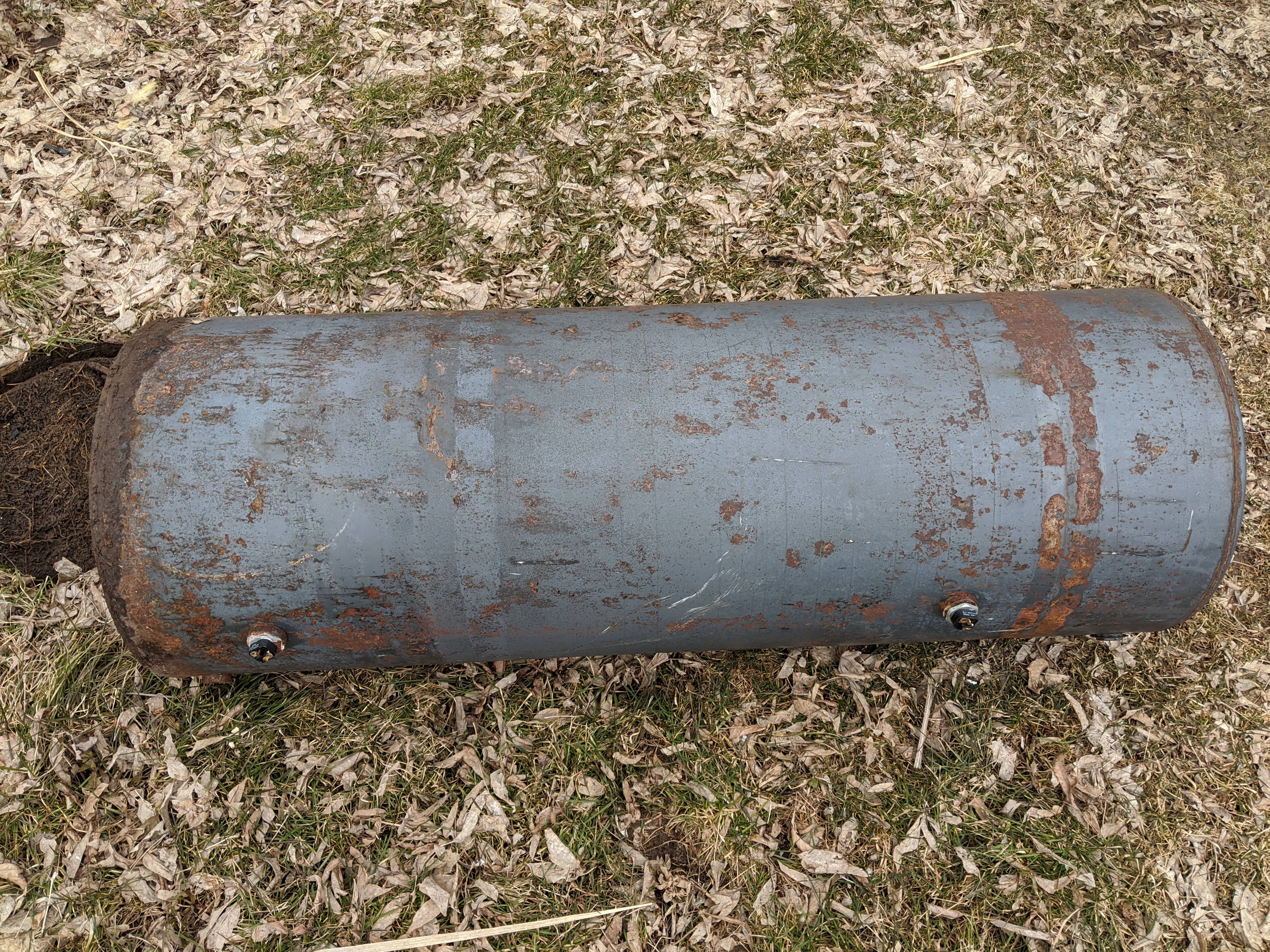don
5 year old buck +
I was inspired by member Semisane, (http://habitat-talk.com/index.php?threads/an-atv-roller-crimper.9144/) to build one of these and except for a little more paint my edition is now finished.
The major changes were pillow block bearings, a rotating ball hitch coupler for un-even ground, and a little additional weight due to a 2"x2" frame and tongue and 1 1/2"x 1 1/2" angle iron welded to the tank rather than 1 1/4" angle iron. The minor difference is a pair of fittings to the tank for both filling and bleeding of the tank when adding/removing the water and a little beefier hardware and tow bar. Dry weight is 252 lbs. and filled weight will be approximately 360lbs from my calculations. My investment including the tank and materials was well under $300.00 but as a non-welder I paid for that to be done at a cost of $115.00 including all cutting/fitting and assembly with my help.




PARTS LIST FOR MY ATV/UTV TOWABLE MINI ROLLER CRIMPER
*** ONE 9” X 48” x 3/8” THICK WALL OXYGEN TANK (measured from remaining length of the tank with both ends of the steel tank cut off)
*** 2 PIECES OF ¼" OR 5/16” FLAT STEEL CUT INTO APPROPRIATELY SIZED CIRCLES FOR COMPLETE COVERING OF THE TANK ENDS
*** TWO 3” x ½” HEX BOLTS WITH NUTS AND WASHERS (the hex ends will be centered and welded to the circle end pieces with each circle then welded in place on each tank end).
*** TWELVE FEET 2” X 2” X 3/16” SQUARE STEEL STOCK (6ft of this is for the tongue).
*** TWO PIECES OF 12” X 1 ½” X 1 ½" x 3/16” ANGLE IRON FOR TONGUE SUPPORT BRACES
*** NINE 4FT SECTIONS OF 1 ½” X 1 ½” X 3/16” THICK STEEL ANGLE IRON
*** TWO PILLOW BLOCK BEARINGS WITH ½" CENTER
*** FOUR 3 ½" X ½" HEX BOLTS WITH WASHERS AND NUTS (for mounting of the pillow blocks to the frame)
*** 24” X 5/8” Plain Steel Round Rod (12” each per axle)
*** TWO 13 INCH TIRES AND RIMS WITH 5/8 INCH CENTER
*** TWO 1 ¼" X 5/8" NUTS (used only as spacers between wheels and frame)
*** TWO 1 ½” COTTER PINS (for use thru drilled holes in axles)
*** 2 INCH STRAIGHT TRAILER COUPLER (I use a 1 7/8” ball)
*** PAINT THE COLOR OF YOUR CHOICE, I USED RUST-OLEUM BRAND FOR RUST PREVENTION.
The major changes were pillow block bearings, a rotating ball hitch coupler for un-even ground, and a little additional weight due to a 2"x2" frame and tongue and 1 1/2"x 1 1/2" angle iron welded to the tank rather than 1 1/4" angle iron. The minor difference is a pair of fittings to the tank for both filling and bleeding of the tank when adding/removing the water and a little beefier hardware and tow bar. Dry weight is 252 lbs. and filled weight will be approximately 360lbs from my calculations. My investment including the tank and materials was well under $300.00 but as a non-welder I paid for that to be done at a cost of $115.00 including all cutting/fitting and assembly with my help.




PARTS LIST FOR MY ATV/UTV TOWABLE MINI ROLLER CRIMPER
*** ONE 9” X 48” x 3/8” THICK WALL OXYGEN TANK (measured from remaining length of the tank with both ends of the steel tank cut off)
*** 2 PIECES OF ¼" OR 5/16” FLAT STEEL CUT INTO APPROPRIATELY SIZED CIRCLES FOR COMPLETE COVERING OF THE TANK ENDS
*** TWO 3” x ½” HEX BOLTS WITH NUTS AND WASHERS (the hex ends will be centered and welded to the circle end pieces with each circle then welded in place on each tank end).
*** TWELVE FEET 2” X 2” X 3/16” SQUARE STEEL STOCK (6ft of this is for the tongue).
*** TWO PIECES OF 12” X 1 ½” X 1 ½" x 3/16” ANGLE IRON FOR TONGUE SUPPORT BRACES
*** NINE 4FT SECTIONS OF 1 ½” X 1 ½” X 3/16” THICK STEEL ANGLE IRON
*** TWO PILLOW BLOCK BEARINGS WITH ½" CENTER
*** FOUR 3 ½" X ½" HEX BOLTS WITH WASHERS AND NUTS (for mounting of the pillow blocks to the frame)
*** 24” X 5/8” Plain Steel Round Rod (12” each per axle)
*** TWO 13 INCH TIRES AND RIMS WITH 5/8 INCH CENTER
*** TWO 1 ¼" X 5/8" NUTS (used only as spacers between wheels and frame)
*** TWO 1 ½” COTTER PINS (for use thru drilled holes in axles)
*** 2 INCH STRAIGHT TRAILER COUPLER (I use a 1 7/8” ball)
*** PAINT THE COLOR OF YOUR CHOICE, I USED RUST-OLEUM BRAND FOR RUST PREVENTION.
Last edited:

